Best ramen shops on the Chuo line
Ride west on the noodle express – here are 20 top pit stops
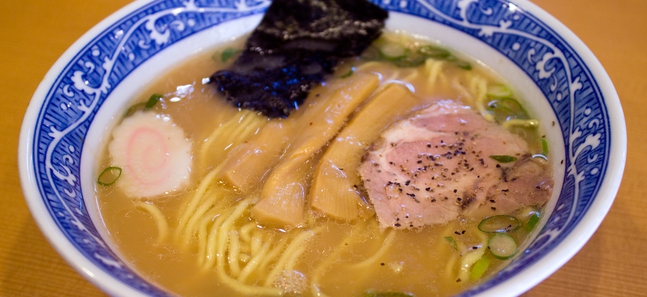
Chuka Soba Aoba (Nakano)
Posted: Fri Mar 14 2014
Surely, you must be familiar with the Chuo line: reaching from Tokyo Station to the wilderness of Otsuki, this train line is one of Tokyo's major commuter links, ferrying hundreds of thousands of people to and from work and school every day. The suburbs along the line are some of the city's most interesting neighbourhoods, many of them renowned as centres of alternative culture, music and food. That last category cannot be adequately discussed without mentioning ramen – shops all the way from Kanda to Kunitachi and beyond serve up their own, locally flavoured versions of Japan's favourite fast food, and often attain great prestige in their respective areas. Our ever-vigilant ramen hunters have been scouring the railside for these local hot spots, and now present a definitive guide to the 20 best ramen eateries on the Chuo line – it's time to charge up your IC card and get slurping.
Kikanbo (Kanda)
Get spicy in Kanda
Kikanbo is famous for its karashibi miso ramen (¥780), featuring a bright red soup deliciously combined with light brown miso to create taste bud-stimulating flavours. The tongue-numbingly spicy soup is a combination of meat- and seafood-based ingredients, four different types of chilli, plus some added Sichuan pepper. You also have a choice of five different spiciness levels. The ‘Karashibi Tsukemen’ (¥850) is also very popular here.
Full details
Daishi (Ochanomizu)
Meet the epitome of the standard ramen
Kuramaebashi-dori's Daishi is characterised by its red signboard. The most popular dish is the shoyu ramen (¥650), designed to be the epitome of the standard ramen. The ingredients are quickly cooked at high heat in order to bring out their flavours and to create a slightly cloudy soup. A traditional Chinese technique for making clear chintan soup stock is then applied, using chicken breast to turn the soup into a clear liquid. This soup, thoroughly cooked by simmering it at low heat so that it looks free of impurities, provides the type of flavour that ranks high above the competition.
Full details
Fu-unji (Shinjuku)
Queue up and dip in
This is the place to go for tsukemen in Shinjuku. The double soup, made with boiled chicken and fish, is thick and creamy and goes perfectly with the flavourful straight noodles. Although the sauce is thick, it does not feel overly heavy, which explains the amount of repeat customers and consistently long queues that reach dozens of metres from the shop both day and night.
Full details
Kaijin (Shinjuku)
End it with a ball of rice
Find this shio ramen restaurant just outside the southeast exit of Shinjuku Station. The menu centres on daily specials, offering soup stock made with five different types of fish. The lightly flavoured soup is topped with perfectly matched cod and prawn dumplings and chicken meatloaf, and also goes very well with condiments like spring onions, ginger, perilla leaves and shredded chilli. We recommend throwing in a grilled onigiri rice ball at the end for a delicious zosui hodgepodge.
Full details
Chuka Soba Aoba (Nakano)
Go west at a true Nakano oldie
This is the original location of a chain of chuka (Chinese) soba restaurants that centres on the Kanto region. The rich soup is based on a traditional recipe from Kyushu, made with chicken meat and pork bones and then mixed with Tokyo-style seafood soup stock. The noodles are thick and relatively straight. The menu includes four different types of dishes, including chuka soba and tsukemen, with the former being the most basic of them all, available at the modest price of ¥650. Being located in Nakano, an area known for its concentration of ramen shops, Aoba's unshakeable popularity is evidence of the level of quality found here. Not too heavy, not too light – you’ll never get tired of these offerings.
Full details
Saikoro (Nakano)
Tour the factory
The famed Nakano eatery Jiraigen was renovated in 2011, with the second floor eventually converted into a noodle factory that also hosts this plucky shop. The highlight here is the ‘Nikuniboshi chuka soba’ (¥730), swimming in a soup made with seafood including dried mackerel, bonito and large quantities of sardines, as well as loads of pork bones. The homemade noodles are crafted from domestic wheat and have a slippery and deliciously chewy texture that reminds us of udon. Topping off the delicious soup and noodles are a generous serving of chashu pork and many other carefully prepared ingredients. The 29th day of every month is ‘Meat Day’, meaning that Saikoro’s signature dish is available for a paltry ¥500.
Full details
Hayashimaru (Koenji)
Check out Koenji's top wantan-men spot
This shrine to wantan-men is located just a few steps into one of the alleyways off Koenji’s main shopping street on the north side of the station. We have to recommend the tsukemen (¥750), served with homemade wheat noodles, and the wantan-men (¥880), made with an excellent homemade broth. The prawn wantan is also a nice choice with its wonderfully soft and chewy texture. The soup here is made with soy sauce, salt, slowly cooked meat like chicken and pork, and vegetables, after which it’s combined with seafood ingredients including kelp, dried sardines and dried bonito to provide wholesome, well-balanced flavours. The medium-thick noodles have just the right texture and consistency. For a ‘best of both worlds’ option, go for the mixed wantan-men (¥940), which allows you taste both the meat and the prawn versions in one bowl. The restaurant also offers a full range of limited-time specials and side dishes.
Full details
JAC (Koenji)
Visit Tokushima by foot
Opened in September 2012 along Kannana-dori close to Koenji Station, this representative from Tokushima offers a soup consisting of soy sauce and a rich pork base, with other ingredients including separately cooked sukiyaki-style pork, boiled eggs, menma bamboo shoots, and bean sprouts. Add a free egg and rice to the 'JAC soba' (¥900) for a true Tokushima experience.
Full details
CiQue (Asagaya)
Turn up the tomato flavour
Best recognised by the signboard with a big globe on it, this shop’s exterior looks as stylish as that of a beauty salon. The restaurant seats only six people at the counter, and the menu includes a grand total of two dishes: shio ramen (¥700), made with light chintan soup, and shoyu ramen (¥750), made with boiled chicken and a seafood soup. Both dishes have their exclusive noodle versions, and even the chashu pork is separated by flavour: shoulder roast for the salt version and chuck roll for the soy ramen. Don’t forget the shiroajidama (¥100) and grilled tomato (¥150) toppings.
Full details
Harukiya (Ogikubo)
Ogikubo's oldie keeps on truckin'
Opened in 1949, Harukiya has been in business for more than 60 years now, and it shows – not only in the shop’s old-school style, but also in the quality of its ramen. This venerable eatery serves a typically Tokyo variety of ramen: chuka soba (¥800), blending chicken and fish stock with fragrant soy sauce to create a well-rounded broth. The wontonmen (¥1,200), chashumen (¥1,300), chashu wontonmen (¥1,700) and tsukemen (¥900) are all also worth sampling, with the option of getting an extra-large portion of noodles – made freshly every morning – for an additional ¥200. Harukiya’s chuka soba is the quintessential version of the dish, and the flavour hasn't changed since the shop first opened – or at least, that's what the old timers will tell you.
Full details
Hatsune (Nishi-Ogikubo)
Taste the unchanging classic
Hatsune has been serving tanmen from its cramped back-alley quarters on the ground floor of an old Japanese house for more than half a century. Seating might be limited – there are just six spaces at the counter – but the menu options are varied, including ramen, wontonmen and yakibuta-men. The most popular dish, however, is the tanmen (¥700), a bowl of shio (salt-based) ramen topped with cabbage, bean sprouts and carrots. All the tastes and textures hang together beautifully: the cabbage is sautéed in a wok to retain its crispiness and flavour, while the clear broth turns out to be unexpectedly packed with umami – don't be surprised if you find yourself draining the bowl once you've finished the noodles. Times may change, but there's no arguing with classic ramen like this.
Full details
Papapapapine (Nishi-Ogikubo)
Go tropical in Nishi-Ogi
Take a right at the south exit of Nishi-Ogikubo Station and you’ll see a pineapple banner and a signboard in black cloth with a printed pineapple on it. You won’t be surprised to hear that the main dish here is pineapple ramen (¥700), made with a soup consisting of a blend of pineapple juice and seafood stock, and offering deep flavours that start with the acidity and sweetness of pineapple, followed by savoury seafood tastes like those of dried sardines and kelp. Toppings include more pineapples, seaweed, and sweet chashu pork seasoned with a sauce made from pineapple juice. Their flavoured eggs are the most amazing thing – available for order as additional toppings, these standard-looking eggs are actually infused with pineapple as well.
Full details
Dokutsuya (Kichijoji)
Sit down with the family
This family-run eatery near Kichijoji Station's park exit offers ramen with soup made from chicken and pork bones, carefully cooked to produce a rich broth, and topped with spinach and thick noodles. Calling the soup rich doesn’t really do it justice, so it would probably be advisable for first-time visitors to order some of the slightly less fatty options. If you’re visiting at night, we recommend first ordering the kyabecha, an appetiser made with finely chopped cabbage and pork soaked in a ‘special sauce’, and downing a beer as you wait for your ramen to arrive.
Full details
Tsukemen Enji (Kichijoji)
Discover the veggie potage
Kichijoji's other representative mixes it up with its veggie creations, modelled on French-style potage soup and consisting of a concoction cooked from pork bones, chicken and seafood, with added vegetable paste made out of yam, onion, apples and other ingredients. This rich and thick soup sticks to the noodles, but the added veg gives it a simple, refreshing taste, making this dish very popular among health-conscious ramen fans. You can choose from three different types of noodles, but first-timers will do well to go for the super-thick wheat germ version. These fluffy, grey noodles, made with whole wheat germs, have the consistency and refreshing texture of soba. Although this is a popular restaurant that often has people queuing outside, visiting outside of lunch hours usually guarantees a seat right away.
Full details
Bunzo (Mitaka)
Get in line in Mitaka
In Mitaka at lunch time? Make sure not to lose your way and head for Bunzo, located on the south side of the station. This small eatery seats less than 10 people at the counter and boasts unrelentingly long queues every day. The most popular item on the menu is the toku-ramen, complete with a double soup made from seafood and pork bones. The medium-thick noodles are mixed perfectly with the bonito broth, and once you dig in, you’ll realise how quickly this dish fills you up. Note that the restaurant closes as soon as it runs out of soup.
Full details
Kiraboshi (Musashi-Sakai)
Go all-out on the pork
This Musashi-Sakai haunt serves up ramen in a decadently thick and rich pork-bone soup. Customers queue up every day at lunch time to sample this delicacy, made by cooking large quantities of pig trotters and heads for a good 30 minutes. The menu includes dishes like tonkotsu-men (¥700), noukou (thick) tsukemen (¥800) and kiraboshi Kumamoto-style ramen (¥750). Servings are topped with cabbage and bonito-flavoured anko bean paste, which can be melted into the soup for a whiff of seafood among the heavy pork flavours.
Full details
Chinchintei (Musashi-Sakai)
Honour tradition in Musashi-Sakai
Located a brisk walk from the station, this ramen shop can be identified by its signboard adorned with yellow and red stripes, and is known as the ancestor of the abura soba, which is essentially ramen served without soup. Chinchintei has provided the same style of menu since 1965 and is always bustling with customers. Their signature dish (¥600) looks extremely simple, and is served with medium-thick noodles topped with menma bamboo shoots, chashu pork and naruto fish paste. The bottom of the bowl is filled with a special sauce full of meat flavours, intended for mixing with the noodles. Every table is equipped with homemade chilli oil and vinegar, allowing you to freely customise the flavour of your dish, and additional toppings like raw eggs (¥50), flavoured eggs (¥100) and spring onions (¥100) are also available. Every fan should visit this holy site at least once.
Full details
Kujira Shokudo (Higashi-Koganei)
For a late-night fix
Opened in September 2013, this dinner-only shop has slowly but surely built up a noteworthy following. The basics on the menu are shoyu ramen (¥670 and up) and shio ramen (also ¥670 and up). These dishes combine wavy noodles and a seafood-based soup with added meat and shiitake mushrooms, and also include basic toppings like thin menma bamboo shoots and chashu pork for a good balance of fatty and meaty flavours. The limited-edition seasonal dishes ensure that you'll always have something new to look forward to, and night owls will be happy to hear that these guys keep their shop open until 1am.
Full details
Mutahiro (Kokubunji)
Sample sardines on Kokubunji's south side
The most popular dish here is the ‘Wahaha niboshi chuka soba’ (¥900), a gently flavoured soup made with dried sardines that avoids the bitterness often found in this type of ramen. They previously served both niboshi soba and chicken soba, but ever since the opening of a branch shop on the north side of the station, this original location has set its focus exclusively on sardine-based creations.
Full details
Kyoka (Tachikawa)
Hold on to your soy sauce principles
Looking like an old town house from the outside, this Tachikawa shop is highly retro on the inside too. As for the noodles, we have to recommend the aromatic and sweet shoyu ramen (¥950), made with seafood-based stock and mixed with high-quality soy sauce and a meat-based broth extracted from multiple types of pedigree chicken. The soup’s surface is sprinkled with duck oil, a curious but enjoyable flavour, while the noodles are straight and flat. Toppings include bamboo shoots, chashu pork, flavoured egg and French parsley, all carefully prepared without compromises. This refined dish is an excellent example of how good Japanese ramen really can be when prepared with care.
Full details
Tags:
Tweets
- About Us |
- Work for Time Out |
- Send us info |
- Advertising |
- Mobile edition |
- Terms & Conditions |
- Privacy policy |
- Contact Us
Copyright © 2014 Time Out Tokyo






























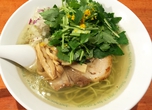

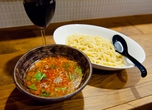
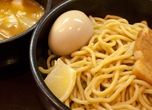

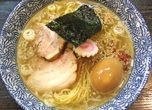


Add your comment